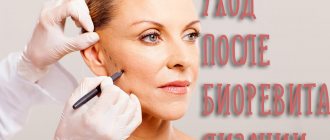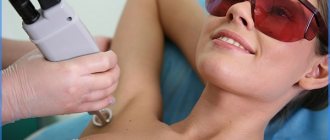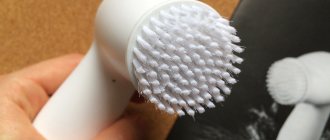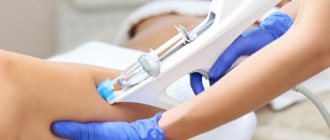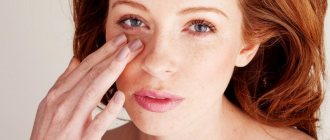Main risks
Not every cosmetologist will agree to perform the procedure on a pregnant or lactating woman, and the preparations themselves will most likely contain a warning that their use is a contraindication for this category of people. It is not surprising that girls are seized with panic: fears begin that the drugs may affect the development of the fetus, and even worries about procedures performed immediately before pregnancy. So where is the truth and what is worth fearing and what not?
Risks for the child
The biggest risk of such injections for a baby is the development of a severe allergic reaction to hyaluronic acid. Not only will you no longer be able to use the same drug even after pregnancy and breastfeeding, but such an allergy can be passed on to the child, whose development is affected by everything that happens to the mother during pregnancy. And if you think: “I’ve been injecting this drug for a thousand years, nothing will happen if I don’t change it,” then we will have to disappoint you. Due to dramatic changes in hormonal levels during this period, allergies can appear even to those substances that your body has accepted normally for many years.
Advice
Many cosmetologists believe that using hyaluronic acid in the second trimester is much safer than in the first.
That's essentially all. Seriously. Hyaluronic acid cannot greatly harm a developing fetus or an already born baby through milk, so in this regard, injections with it are less harmful than bad food, polluted air in a metropolis, alcohol and smoking.
Risks for women
Why does a cosmetologist refuse to see you? This has less to do with concerns about your baby and more to do with your body's reaction to the procedure. If this is not your first time getting injections, then you probably know that even during menstruation, the procedure is carried out reluctantly. Just because of changes in hormonal levels! And during menstruation they are incommensurate with what happens during pregnancy and breastfeeding.
What can your impatience cost?
- The worst thing is allergies, which we have already mentioned. It happens less often than you might now think, but the problem is that there is no way to predict the reaction.
- The second most unpleasant thing is an effect that does not meet expectations. Due to the same hormones, tissues may not accept hyaluronic acid as usual, and it will be absorbed as luck would have it. This can cause asymmetry, which you won't like very much if you're doing lips, or bumps that look even worse than the wrinkles themselves. Add to this the cases when the hyaluronic acid dissolves not after six months or a year, but after a couple of months, and think twice before spending money.
Important!
If you took injections during your first pregnancy and everything was fine, this does not mean that everything will be the same during your second pregnancy. Pregnancies go differently for one woman, and this is no secret, so you shouldn’t relax.
- Another disadvantage of such procedures is pain and long recovery, which occurs due to the influence of hormones on blood clotting and pain threshold. On the one hand, pain, swelling and bruises can be endured, but on the other hand, such a procedure will be stressful for the body, and any stress during pregnancy indirectly affects the baby.
- You can also think about this: your body’s immunity is weakened, so the risk of getting an infection even with the “direct hands” of a cosmetologist increases greatly. Is it worth torturing an already weakened body?
Is hyaluronic acid dangerous when breastfeeding? It is still not recommended to do it due to hormonal changes, but the risks remain the same. Of course, everyone’s body is unique, and some will experience these effects of hyaluronic acid, while others will not. But is it worth the risk?
Contraindications for carrying out
No cosmetic procedure is suitable for absolutely everyone, since individual anatomical factors and allergic reactions can become an obstacle to skin renewal.
Local
Recurrent herpes. If rashes have previously been observed on the skin in the area where mesotherapy is planned, injections should be approached with caution, as they can provoke its aggravation.
Are common
Epilepsy, convulsive seizures. With these ailments, an attack may begin in response to irritation of the skin with a needle. In this case, muscle contraction can break the needle and it will remain under the skin.- During treatment with photosensitizing drugs. Taking certain pharmacological drugs (tetracycline, fluoroquinolone, etc.) reduces skin resistance to ultraviolet radiation. Therefore, during the hot season, during mesotherapy, pinpoint hyperpigmentation may remain on exposed parts of the body and at injection sites.
- Diseases that accompany an increase in body temperature , colds, chronic ailments during the period of their peak activity. During this period, any cosmetic procedures are not recommended.
- Pregnancy and breastfeeding. Mesotherapy itself does not harm the baby, but it can change the metabolism of the mother's body, which will affect the development of the fetus.
- Individual intolerance , a factor that does not depend on any factors other than genetics. Certain substances may be incompatible with your body.
Absolute
- Oncological diseases. Cancer cells grow along with the entire body.
Certain substances that are used during mesotherapy can not only influence the hormonal system, trigger the secretion of growth hormone (somatotropin), but also contain it in their composition. The hormone grows everything in the body, including cancer cells. To ensure safety, you need to take a blood test for tumor markers. - Blood clotting disorder. Hemophilia and other significant bleeding disorders, therapy with drugs that reduce blood clotting. If blood clotting is impaired, even with mesotherapy using very thin needles, severe bleeding or hematoma formation is possible.
- Allergy. Allergic reactions can occur not only due to rejection of the active substance, but also from other factors. For example, the area of skin where surgery was performed becomes more sensitive and vulnerable to infections and allergy triggers. Also, after any introduction of exogenous substances, histamine receptors work in enhanced mode to eliminate the chance of bacteria entering the body.
- Pathological fear of injections. A subconscious fear of injections will greatly slow down recovery and cause a lot of discomfort, since the nervous system will be tense all the time, which will affect performance, sleep, and quality of life.
Other diseases
With diseases of the immune system, any introduced substance will be absorbed more slowly. If there is a serious autoimmune disease, an infiltrate forms. This is a situation in which the injected substance is wrapped in a film until the protective system finds out what is inside. All this time there will be a lump and swelling at the injection site. If the infiltrate does not resolve in a short time, then it can only be removed surgically.
Temporary
For a cold. A cold lowers the immune system and takes away strength from the entire body. Even such a simple disease, familiar to us, can greatly spoil the effect of the operation. In addition, during a cold, inflammation progresses in the body, which increases the temperature. In such a situation, it is better not to carry out mesotherapy for two reasons:- it will require strength for restoration, which is already in short supply;
- the chance of infiltration increases several times.
- Infectious inflammatory processes in the treated area. The injection can carry bacteria from the surface of the skin deeper, thereby worsening the condition of the skin. An exception is the treatment of infections and inflammatory processes using mesotherapy.
- Acne in the acute stage. Blackheads (or acne) are inflammations of the sebaceous glands that become clogged with sebum. The visible area of acne is the tip of the iceberg, but in fact, the area of inflammation under the skin can be several times larger than the spot on the skin. For this reason, mesotherapy should not be performed in areas where rashes are present.
- At a temperature. An increased body temperature will slow down the recovery process, since all the body’s forces are aimed at lowering the temperature and stabilizing the body’s condition.
- After peeling. Peels (laser peel performed less than 1 month ago, medium chemical peel performed less than 2 weeks ago).
Before performing mesotherapy, you need to wait until the skin is completely restored.
For women
During pregnancy
Pregnancy is a complex and individual process that occurs differently for everyone. The fruit is protected by several layers:
- Mother's immune system.
- Blood-brain barrier.
- Placenta.
- Child's immune system.
Only very strong infections can penetrate these layers, which means that the chance of causing damage to the fetus is extremely small . Take a closer look at when it rises.
In the early stages
At the very beginning of pregnancy, a large number of changes occur in the mother's body. This is the most dangerous time for infection. The immune system is switched off at times in order not to interfere with the growth of new types of tissues and cells (placenta, rudimentary tissues of the embryo, etc.).
When breastfeeding
When the child is already born, nothing threatens the mother’s body since all systems work at 200% so that she can feed the child. This mechanism is present in all mammals.
During your period
The only adverse reaction that can occur to a patient during menstruation is swelling. The face, like any area of the body, will be swollen, which means the medications will be absorbed more slowly. The outflow of lymphatic fluid will be worse, which will lead to blue skin at the injection site.
Why hyaluronic acid is safer than it might seem
Don't the risks seem so scary to you? Of course, hyaluronic acid is already contained in your body, so it would be strange to fear mutations or defects. This is not Botox, which is essentially poison: its contraindication during pregnancy is much more justified! It is hyaluronic acid, along with collagen and elastane, that is responsible for skin elasticity, as well as the health of joints, cartilage and ligaments.
Yes, synthesized hyaluronate is used to create preparations, but with high-quality cleaning it does not cause allergies and is absolutely safe. That is why, when deciding on the procedure, you need to take a responsible approach to choosing a filler. Not only cleaning is important here, but also the presence of accompanying components: in most cases they are the culprits of allergies.
By the way
Additional substances in preparations based on hyaluronic acid may not be as safe as the hyaluronic acid itself. They are unlikely to cause much harm, but they can slightly worsen the overall background for the baby’s development.
But since hyaluronic acid is relatively safe, why are cosmetologists and manufacturers so categorical about their prohibitions? The fact is that due to hormonal imbalances, no one can predict your body’s reaction to the procedure and everyone wants to protect themselves. What if an allergy manifests itself in your case and you decide to go to court? And this applies to any drugs and manipulations in the medical or near-medical field. Any pill will say, if not “contraindicated during pregnancy,” then “consult your doctor if pregnant,” for sure!
It turns out that there are different contraindications to contraindications, and hyaluronic acid during pregnancy is certainly not comparable to taking dangerous medications.
What about dietary supplements and creams?
Cream with hyaluronic acid during pregnancy is no worse or better than other creams. Considering that the acid itself is safe and even healthy, you need to worry more about the other ingredients in the composition than about it. Of course, you shouldn’t count on a super effect: if creams could replace invasive cosmetology, no one would use it.
The situation with dietary supplements is similar. Surely on the jar you will find a warning that it is better to consult a specialist in advance: now we know that in the case of hyaluronic acid this is more of a warning than a contraindication. When taken orally, hyaluronic acid itself has virtually no effect on the condition of the skin (the body sends it to more needed places), but it perfectly compensates for its deficiency in joints and cartilage, which is also not bad.
It’s up to you to decide whether to buy creams, take dietary supplements and give injections. If you want to reinsure your baby, and you don’t want any unnecessary problems, it would be better to be patient. But if you can’t imagine life without injections, know: they are not so scary. If you approach the choice of drug wisely and are mentally prepared for pain and minor troubles in the form of swelling and bruises, you can take risks in agreement with a cosmetologist! In the end, for a child with a good drug, the risk from injections is minimal, and his development is much more influenced by the correct regime, nutrition and ecology. So you better think about it!
Is it permissible to use hyaluronic acid during lactation?
This technique, called contouring, is based on the introduction of various fillers (fillers) made of collagen - also a natural component of the skin - and hyaluronic acid into the lips. The latter has the ability to hold a large volume of water, due to which the lips are given the desired size.
E-lactancia (a well-known online directory for checking drugs for compatibility with breastfeeding) indicates an extremely low risk of using acid for breastfeeding.
The reason for this is the very high molecular weight of the substance, which prevents its penetration into breast milk. Breastfeeding experts say the same thing.
Doctors working in the field of aesthetic medicine have a different point of view. Although the introduction of such a small amount of a substance “native” to the body cannot harm the mother’s health, cosmetic surgery specialists often refuse to give filler injections to nursing mothers. The reason lies not in the acid, but in the anesthetic, which is necessarily administered before injections. All anesthetics used (novocaine, ultracaine and lidocaine) are not recommended during breastfeeding, except in cases where it is impossible to do without them - for example, toothache.
The use of fillers is far from the only method of lip augmentation. Also slightly less popular are:
- Thread lifting. Installation of self-absorbable caprolactone threads along the contour of the lips, which tighten them and form new fibrous tissue.
- Operation Bullhorn. Turning the border of the lips outward, as a result of which they become more voluminous.
- VY-plasty. A technique similar to the previous one, but involving incisions in the shape of the letters “V” and “Y”, which allows not only to enlarge the lips, but also to change their shape.
- Installation of silicone implants.
- Electroporation. A relatively new technology, which consists in introducing the same hyaluronic acid using a non-injection method using a special electrical device. Acid molecules penetrate the skin through the excretory ducts of the sweat glands. The effect of the procedure lasts from six months to a year, depending on the patient’s age and skin parameters.
However, the first four procedures require local or general anesthesia, which is again incompatible with breastfeeding. It is not entirely clear why electroporation cannot be used during pregnancy and breastfeeding, but the prohibition may be related to the operating characteristics of the device.
If a nursing mother does not want to wait for the end of lactation, you can resort to alternative methods of lip augmentation.
Is it possible to enlarge lips while breastfeeding?
Only a few girls and women are satisfied with every detail of their appearance. The increased availability of plastic surgery allows them to adjust their appearance in ways that no cosmetics can, and the most popular procedure is lip augmentation. As for nursing mothers, they are usually wary of such an operation after hearing about hyaluronic acid, which in most cases is used for lip augmentation. Let's figure out whether this substance is dangerous for nursing mothers and whether there are alternative methods.
Hyaluronic acid: what it is and how it works
Hyaluronic acid is an absolutely natural compound for the body, synthesized by a group of so-called membrane proteins. There are approximately 15 grams of this substance in the body of a 70-kilogram person.
Among the functions of acid, three main ones can be distinguished:
- is one of the most important components of the synovial fluid that fills the joint cavities;
- maintains the elasticity of cartilage;
- participates in skin regeneration.
Based on the properties of hyaluronic acid, medicine began to use drugs based on it to treat cataracts, osteoarthritis and smooth out wrinkles, and cosmetology adopted this substance for the manufacture of creams, lotions and lipsticks.
Is it permissible to use hyaluronic acid during lactation?
This technique, called contouring, is based on the introduction of various fillers (fillers) made of collagen - also a natural component of the skin - and hyaluronic acid into the lips. The latter has the ability to hold a large volume of water, due to which the lips are given the desired size.
E-lactancia (a well-known online directory for checking drugs for compatibility with breastfeeding) indicates an extremely low risk of using acid for breastfeeding.
The reason for this is the very high molecular weight of the substance, which prevents its penetration into breast milk. Breastfeeding experts say the same thing.
Doctors working in the field of aesthetic medicine have a different point of view. Although the introduction of such a small amount of a substance “native” to the body cannot harm the mother’s health, cosmetic surgery specialists often refuse to give filler injections to nursing mothers. The reason lies not in the acid, but in the anesthetic, which is necessarily administered before injections. All anesthetics used (novocaine, ultracaine and lidocaine) are not recommended during breastfeeding, except in cases where it is impossible to do without them - for example, toothache.
The use of fillers is far from the only method of lip augmentation. Also slightly less popular are:
- Thread lifting. Installation of self-absorbable caprolactone threads along the contour of the lips, which tighten them and form new fibrous tissue.
- Operation Bullhorn. Turning the border of the lips outward, as a result of which they become more voluminous.
- VY-plasty. A technique similar to the previous one, but involving incisions in the shape of the letters “V” and “Y”, which allows not only to enlarge the lips, but also to change their shape.
- Installation of silicone implants.
- Electroporation. A relatively new technology, which consists in introducing the same hyaluronic acid using a non-injection method using a special electrical device. Acid molecules penetrate the skin through the excretory ducts of the sweat glands. The effect of the procedure lasts from six months to a year, depending on the patient’s age and skin parameters.
However, the first four procedures require local or general anesthesia, which is again incompatible with breastfeeding. It is not entirely clear why electroporation cannot be used during pregnancy and breastfeeding, but the prohibition may be related to the operating characteristics of the device.
If a nursing mother does not want to wait for the end of lactation, you can resort to alternative methods of lip augmentation.
Methods of lip augmentation approved for nursing mothers
These include the following six methods:
- Lip massage. Least effective procedure. Even when a visible result is achieved, the effect does not last long. A more extreme version - vacuum lip augmentation by suction to the neck of a bottle or narrow glass - is completely traumatic, although it promises a strong but short-lived effect.
- Lip exercises. These include silent pronunciation of vowels, stretching out lips, exhaling air through a slit in the lips, etc. A safe but low-effective method, which also requires regular practice.
- Thermage. Heating of collagen fibers using high-frequency but low-power radio radiation. Suitable for mothers during breastfeeding, it does not require anesthesia, but the effect is hardly noticeable.
- Correct makeup. Visual enlargement of the lips is achieved by tracing their contour with a pencil.
- Lip tattoo. Allows you, firstly, to make them a little more magnificent, and secondly, to change their color and make them clearer. Due to unpleasant sensations, it is not recommended during pregnancy, but is quite safe during breastfeeding.
- Lipolifting. The essence of the method is to inject the patient with her own fat cells taken from the buttocks, thighs or abdomen. The fat is thoroughly cleaned and injected into the lips using a syringe. Lipolifting in the facial area does not even require local anesthesia, making it completely safe. The effect lasts up to 3 years.
The lip fillers based on hyaluronic acid, which are so popular today, do not in themselves pose any danger, but the procedure for their administration is preceded by local anesthesia, which is undesirable for nursing mothers. The “black list” also includes thread lifting, all types of lip surgery, installation of implants and electroporation. Procedures allowed during breastfeeding include massage and lip exercises, Thermage, visual lip augmentation with makeup, tattooing and the most effective method - lipolifting.
AmyMama.ru


